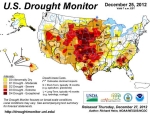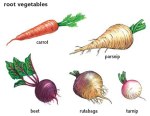 This will be my last blog post for 2012. So, you will need to suffer through my whining about the 2012 weather and my past mostly failed gardens plans.
This will be my last blog post for 2012. So, you will need to suffer through my whining about the 2012 weather and my past mostly failed gardens plans.
My Tiny Farm Normal, if there is such a thing as normal weather. Average Annual Rainfall is about 33 inches.
Days With Precipitation: 60 mostly in May and June and again in September and October.
Thunderstorm Days: 50 – Hail storms producing hail 1 inch or larger: 4 per year.
Snow, sleet or Ice storm days 6
Growing Season is about 220 days
Highest temperature recorded this (2012) summer was 118 degrees with another 8 or 10 days exceeding 114 degrees.
I have suffered under Severe, Extreme and Exceptional drought conditions for the past 5 growing seasons. 2013 will likely be my 6th year to see below normal rainfall and above normal temperatures. At this rate we will soon tie the 7 year drought of (1949-1956). However depending on who’s data you look at we are still 8 years away from reaching the 15 years (1922-1937) drought that was at the heart of causing the so called Great American Dust Bowl.
Lakes that provide tap water for cities and towns and many of us that live in the country are drying up. Most areas are under water rationing plans of one sort or another. When summer time daily evaporation rates are 1/2 to 3/4 of an inch daily, using tap water to apply 1/2 – 3/4 inch water daily watering gardens, lawns, shrubs, fruit trees and such is not a viable option.
Even reverting to a few containers to grow vegetables I sometimes have a failed effort. With the heat and evaporation rates, I must be home to water container plants at least 1 time and some days 2 times a day or the hot dry winds kill my plants.
Grin .. it’s not easy being an Okie on a Tiny Farm in Southwest Oklahoma.
After all my whining about the weather, I will still till my garden plot and plant my garden hoping my long running hot, dry spell will soon come to an end.
 Cool weather root crops like radish, beet, Turnips and onions will get planted in mid-March and sweet corn first week of April. Warmer weather crops like Zucchini, Yellow Summer Squash and Cucumbers will get planted the first or second week of May followed by Okra, Peppers and Tomato’s last week of May. I plan on planting 2 or 3 Tomato’s and Cucumbers in containers in mid-May as well.
Cool weather root crops like radish, beet, Turnips and onions will get planted in mid-March and sweet corn first week of April. Warmer weather crops like Zucchini, Yellow Summer Squash and Cucumbers will get planted the first or second week of May followed by Okra, Peppers and Tomato’s last week of May. I plan on planting 2 or 3 Tomato’s and Cucumbers in containers in mid-May as well.
Spring planted cole crops like Cabbage and Brussels sprouts and Broccoli tend to bolt to make seed before I can harvest a spring, summer crop, so cole crops will be planted mid to late July for a fall crop weather permitting.
I lost my entire herb garden the past 2 summers to the dry hot weather followed up by cold dry winters, but, I will try again in large container that will reside on my back porch.
Not from the U.S.A. Leave a comment telling us about your home town and country
Happy New Year
Why is common sense so uncommon?
Don’t be Shy. Leave me your comment(s)

Do you think it would be worth trying some windbreak/shade giving trees? Off the top of my head I’d suggest eucalyptus, because Australia is hot and it comes from there…! Perhaps that would help reduce evaporation, and the tree roots would be deep enough not to disturb your crops?
LikeLike
Re: NorthernMonkeyGirl – Thanks for taking time to visit my tiny blog.
Great minds think alike, I’m looking into planting a hedge around my garden area using a native wild plums.
LikeLike
Thank you for following my blog. You are an inspiration, I have enjoyed reading about your farm and garden. My husband and I lived on a larger farm in Australia and have now down sized to a smaller farm of 80 acres with approx 5 acres of garden, to start to enjoy the simple things in life. I have a small veggie garden and love arts and crafts, we have cattle to help keep the grass down and to keep my husband busy. The cattle are much easier to handle than the sheep that we had on our larger farm.
Thank you again, I look forward to your next update. Happy gardening and farming.
LikeLike
Spring and Fall crops may be best in these conditions, with lots of compost cover during the hot months. Would a greenhouse provide some protection & allow the water to recirculate through evaporation/condensation? That is a lot of up-front cost though.
Oscar
LikeLike
re: hermitsdoor – green house, hoop house and so on do not work well here, The strong winds can cause a lot of damage or you may even your green house a mile or two down the road. When exposed to direct sun, and temperatures start hitting 90+ degrees the temperature of a green house / hoop house can soar into the 140-160 degree range by mid afternoon. Cooling such a structure is to costly for most people I know.
LikeLike
Hi, have you looked at more passive approaches to gardening such as Bill Mollison’s permaculture, and Fukoaka’s natural farming methods? permaculturenews.org how to build a permaculture vegetable garden Im researching climate change, and really appreciate the words of Fukoaka that we need to distribute seed pellet bombs across all landscapes to give any biomass a chance of growing….
I would be very interested as to what your predecessors (the indigenous inhabitants did) in terms of gardening and stock management?
LikeLike
Gardening is a challenge at the best of times but the climate changes that are happening these days aren’t making it any easier. Let’s hope next year will be a bit better.
LikeLike
We had some exceptional weather here in Central California as well. I lost part of my summer crop when we had a string of triple digit days followed by night lows that weren’t all that low. This autumn we had a freak freeze that wiped out my winter garden.
In riding a horse, we borrow freedom
LikeLike